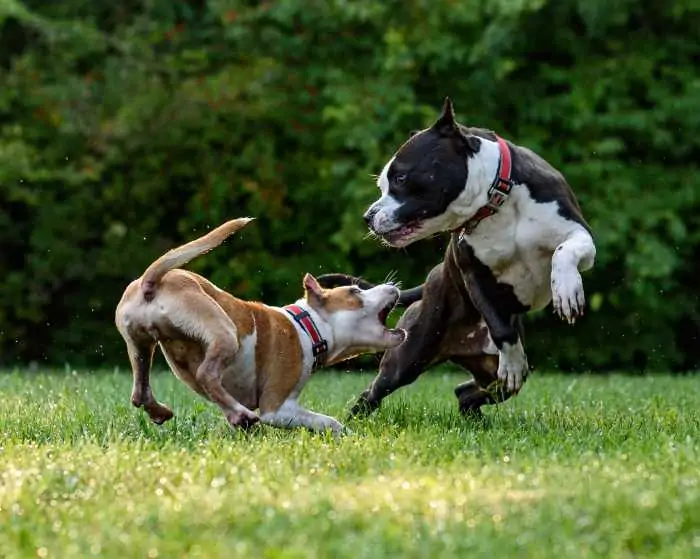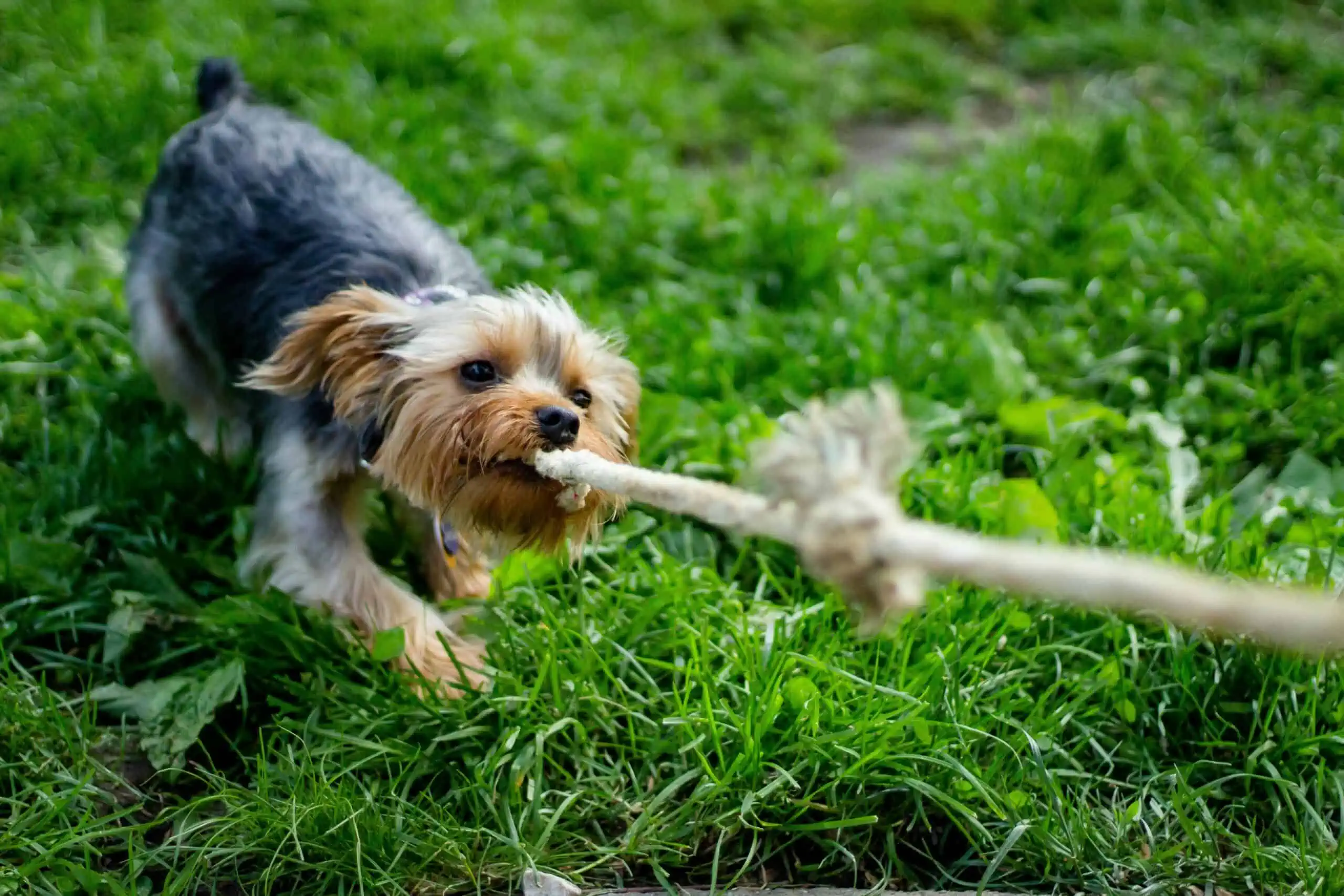Border terriers were originally bred to chase and flush out small prey from their burrows along the borders of England and Scotland. Today, they are still high-energy dogs that need plenty of exercise and stimulation, but they can make great family pets.
However, some border terriers may become aggressive if they don’t get enough exercise or if they feel threatened. If you’re wondering why is my border terrier aggressive, here are a few possible reasons:
Lack Of Exercise
If your border terrier isn’t getting enough exercise, it may start to act out in other ways, including aggression. It does this to utilize all the pent-up energy.
Be sure to give your dog at least an hour of exercise each day. This can be a combination of walks, runs, games of fetch, or anything else that gets them moving.

Fear Or Insecurity
Border terriers may become aggressive if they feel scared or insecure. This could be due to a traumatic experience, such as being taken away from their littermates too early or being abused.
It could also be due to genetics, as some dogs are simply more prone to anxiety than others. If your border terrier seems overly fearful or anxious, it’s important to seek professional help from a veterinarian or animal behaviorist.
Possessiveness
Some border terriers may become possessive of their food, toys, or even their people. This type of aggression is often seen in dogs that were not properly socialized as puppies.
If your border terrier is displaying possessive aggression, it’s important to seek professional help so that the behavior can be corrected before it becomes too ingrained.
If you’re concerned about your border terrier’s aggressive behavior, it’s important to consult with a professional who can help you determine the cause and create a plan to correct the behavior.
A Brief History Of The Border Terrier Breed
The origin of Border Terriers goes back to 1880s England when farming and shepherds were using this breed to control a fox population. Their name refers directly to border hunting in Northumberland.
These dogs were fierce and stubborn. They wanted to kill foxes, stand by their hiding places, and chase them.
Are Border Terriers Always Aggressive?
Border terriers are exceptionally loving family pets and a popular breed amongst children. They are intelligent and courageous; they are very devoted, and they tend to befriend others in their breeds or cats.
However, temperamental traits often occur when dogs become aggressive. Because they hunt, they will often chase and bark at the smaller animal.

Training
As part of training, dog owners should socialize their terrier as early as possible and in a way that will help them achieve the best temperament. Then the dog will be able to adapt well to adulthood. Do not be too harsh on dogs training because they can get hurt.
Please understand that it can only think independently because of its nature. It’s easy when it loses focus during dog training, but it has to work harder to get back on its feet. Also, be aware he is not afraid to chase. You can also take help from a professional dog trainer.
Border Terrier: Staying Healthy
Although Border Terriers are usually healthy you should know that they have some health problems. Adult Border Terriers are usually 11 to 16 inches tall, and between 11 and 16 kg. The life span is about 12 to 15 years.
Common Health Issues
Although most border terriers are generally healthy dogs, some health conditions are more common in this breed than others. Here is a look at some of the most common health issues seen in Border Terriers.
One of the most common health issues seen in Border Terriers is called Legg-Calvé-Perthes disease. This is a condition that affects the ball joint of the hip, causing it to deteriorate. It typically occurs in young dogs between 4 and 6 months of age.
Symptoms include lameness, pain, and muscle wasting. Treatment typically involves surgery to remove the affected ball joint and replace it with a prosthetic.

Another common health issue in Border Terriers is von Willebrand’s disease. This is a bleeding disorder that is caused by a deficiency of certain clotting factors in the blood. It can cause excessive bleeding from minor cuts or trauma, as well as nosebleeds, bloody stool, and blood in the urine.
Von Willebrand’s disease is usually diagnosed with a blood test, and treatment typically involves medications to help control bleeding episodes.
Border Terriers are also prone to skin allergies, which can cause itchiness, redness, and hair loss. Common allergens include pollen, dust mites, mold spores, and food ingredients.
Treatment depends on the underlying cause of the allergies and can involve avoiding exposure to allergens, changes in diet, or medication.
While some health conditions are more common in Border Terriers than in other breeds, overall they are healthy dogs with a lifespan of 12-15 years. With proper care and regular vet checkups, your Border Terrier will enjoy many happy and healthy years by your side.
Grooming
Border Terrier’s coat is double, shedding regularly. A simple brush once or twice a week will suffice. During the shed season, however, expect to spend an entire day stripping the coat either with hand-held instruments and/or specialized equipment.
It’s not necessary to bathe Border Terriers. Bathing his hair removes his coat’s protective capability. To wash him off, use a comb and dry towels. There are plenty of haircuts to offer to your Border Terrier.
Border Terrier Adoption And Rescue
In some cases, your local shelter may offer puppies for adoption. If they’re no longer available at your inspection, please return them later.

Adopting can be very helpful when you want Border Terrier mixtures. If you’ve only ever purchased a single purebred from a very expensive breeder!
One other advantage to adopting a rescue dog is that they try to make it possible for them to rehome them. Wouldn’t you consider bringing home dogs who have never bitten humans before? That’s what shelters are aiming for.
Border Terrier Puppies For Sale
The price ranges from $1,000-$1500 per puppy and will vary by breed and age. Dogs that cost more are expected to be supplied with all the necessary documentation and medical clearance.
Signs Of Aggression In Dogs
It’s vital to identify when dogs act aggressively to stop them from attacking. Sometimes a temperamental trait like screaming or grumbling sound seems quite scary and frightening.
When a dog’s body language changes, it seems alarming because they appear bigger and make direct eye contact or gazes at you directly. Early detection can help prevent dog attacks.
Other Dogs Vs Border Terriers: Possible Cause Of Higher Aggression
The strong instincts to chase and catch can often be seen in Border Terriers who live in households with other small animals. In addition, Border Terriers may become aggressive if they feel threatened or agitated.
If a Border Terrier feels that its territory is under threat, it turns aggressive to protect what it perceives as its own space. Border Terriers may also become aggressive if they are not properly socialized.
Without exposure to different people and situations, Border Terriers may become fearful and react to new experiences with aggression. Proper socialization is essential for Border Terriers to prevent aggression.
What triggers dogs to be aggressive?
There is no single answer to this question as it depends on the breed and individual temperament of the dog. However, research has shown that certain breeds tend to be more prone to aggression than others, such as border terriers.
The most common triggers for aggressive behavior in dogs are fear and territoriality. When a dog perceives a threat, either real or perceived, it may become aggressive to protect itself or its territory from the potential harm posed by another animal or person.
Other triggers include lack of socialization, overexcitement, pain or illness, resource guarding, and even boredom and frustration. Dogs that have been poorly socialized may also become aggressive, as they lack exposure to different sights, sounds, and experiences.
In some cases, aggression can also be triggered by environmental factors like loud noises or unfamiliar people entering the home. It’s important to understand what might be triggering your dog’s aggressive behavior so that you can take steps to avoid or reduce the aggression.
It is important to remember that all dogs are individuals, and some may have genetic predispositions toward aggression.
How do I stop my terrier from being aggressive?
The best way to stop your terrier from being aggressive is to identify and address the underlying triggers for his behavior. This can include making sure he has plenty of positive socialization, providing ample outlets for physical and mental stimulation, and avoiding situations that may cause him stress or discomfort.
It is particularly important to seek professional help if you are unable to manage aggression issues on your own. Your veterinarian or an animal behaviorist can work with you to create a plan tailored specifically to your pet’s individual needs.
Additionally, various behavioral modification techniques may be used to reduce or eliminate aggression behaviors in dogs, such as desensitization and counterconditioning. In some cases, medications may also be prescribed by a veterinarian to reduce aggression levels.
In any case, it is important to understand that aggressive behavior in dogs should never be punished or reinforced with negative reinforcement.
How do you train an aggressive border terrier at home?
Training an aggressive border terrier at home can be a challenging task, and it is important to remember that all dogs are unique individuals. To start, you will need to understand the triggers of your dog’s aggression to be able to avoid or minimize them.
Once you have identified the sources of his aggression, it is time to begin training your pet using positive reinforcement methods like reward-based training. This type of training works by rewarding good behavior with treats or praise for your dog to learn which behaviors are acceptable and which ones should be avoided.
Your goal should be to build a trusting relationship with your pet so that he feels confident around you and other people. Make sure you take things slowly, as pushing too hard or too fast can lead to more frustration and aggression.
Additionally, it is important to remember that training an aggressive border terrier at home requires patience and consistency. With the right approach and guidance, you can successfully train an aggressive border terrier and help him become a well-behaved member of your family.
Is it okay to hit a dog for bad behavior?
No, it is not okay to hit a dog for bad behavior. Hitting a dog as a form of punishment can cause physical harm, and emotional distress, and can damage the bond between you and your pet.
Instead, it is important to train and discipline your dog using positive reinforcement techniques such as reward-based training, redirection, and clear communication. Positive reinforcement involves rewarding good behavior with treats, praise, and attention while ignoring or redirecting bad behavior.
This will help your pet learn which behaviors are acceptable and which should be avoided without causing any harm or distress. This approach not only encourages good behavior but also helps to build a strong and trusting relationship between you and your dog.
If you are struggling to manage your dog’s behavior, it is recommended that you seek the advice of a professional dog trainer or behaviorist who can guide effective training methods and techniques.
Are Border Terriers snappy?
Border Terriers are generally a friendly breed, but they can become aggressive in certain situations. They tend to be more likely than other breeds to exhibit aggression towards small animals, such as cats and rabbits, due to their strong prey drive.
Additionally, Border Terriers may exhibit snappy behaviors if they perceive a threat or if their needs are not met. As with any breed of dog, early socialization and training are key in preventing any potential aggression issues.
Early intervention is key in preventing aggressive behaviors before they become established. If your pet does show signs of aggression, seeking professional advice from a veterinarian or animal behaviorist is recommended.
Proper socialization and training can also help to prevent and manage snappiness in Border Terriers. With patience, consistency, and positive reinforcement techniques such as reward-based training and clear communication, you can successfully train an aggressive Border Terrier and help it live a happier and healthier life free of aggression.
How aggressive are terriers?
Terriers are a group of breeds that were originally bred for hunting and killing small prey, such as rodents and foxes. As a result, they possess a strong prey drive and can sometimes exhibit aggressive behaviors toward other animals.
However, it is important to note that not all terriers are inherently aggressive and their behavior can vary based on factors such as training, socialization, and individual temperament. Terriers can also exhibit aggression towards humans if they perceive a threat or if they are not properly socialized.
Early socialization and training are crucial in preventing aggressive behaviors in terriers, as it helps them to develop appropriate behaviors toward people and other animals. Overall, it is important to remember that aggression in terriers is not a breed-specific trait and can be seen in any dog if they are not properly trained and socialized.
It is always best to work with a professional trainer or behaviorist to address any potential aggression issues in terriers or any other breed of dog.
| Preventative Measures | Description |
|---|---|
| Proper Socialization | Early socialization is crucial for Border Terriers to learn appropriate behavior around humans and other animals. Gradually exposing them to different environments, people, and other dogs can help reduce the likelihood of fear and aggression. |
| Positive Reinforcement Training | Using positive reinforcement training techniques can help Border Terriers learn obedience and good behavior without fear or pain. Consistent training can also reinforce their bond with their owner and reduce anxiety. |
| Exercise and Stimulation | Border Terriers are high-energy dogs and require regular exercise and mental stimulation. Boredom and pent-up energy can lead to destructive behavior and aggression. Providing them with enough exercise and mental stimulation can help reduce stress and anxiety. |
| Health Maintenance | Maintaining your Border Terrier’s health is important in preventing aggression. Regular visits to the veterinarian can identify and address any underlying medical conditions that may contribute to aggression. |
| Responsible Ownership | Responsible ownership includes providing adequate food, shelter, and veterinary care for your Border Terrier. It also involves understanding and respecting their behavior and body language, as well as being aware of any potential triggers for aggression. Properly securing and supervising your dog in public and around other dogs and humans is also important in preventing aggression. |
On the Whole
In conclusion, a Border Terrier’s aggression can be caused by a variety of factors such as fear, anxiety, lack of socialization, territorial behavior, or past traumas.
Dog owners need to identify the underlying cause of their Border Terrier’s aggression and work with a professional dog trainer or behaviorist to develop a personalized training plan that addresses the root cause of the behavior.
Punitive measures such as hitting or yelling at the dog should never be used, as they can exacerbate the aggression and cause further harm. With patience, consistency, and positive reinforcement, many Border Terriers can overcome their aggressive tendencies and become loving, well-behaved companions.


















